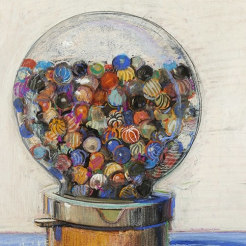
Wayne Thiebaud
Three Half Cakes, 1966
Oil on canvas
16 x 28 inches
Private Collection
Thirty works by the late, great Bay Area painter are at the Berggruen Gallery
The late Wayne Thiebaud, who passed away on Christmas Day last year at age 101, was a formidable force in the mid-century Bay Area Figurative Movement, alongside David Park and Richard Diebenkorn, and made a place for himself in the New York and L.A. dominated Pop Art of the 1960s. Thiebaud didn’t consider himself an artist, though: simply a painter. The difference being, he said that art is something indefinable, while painting is easy to classify. The visceral experience of looking at his paintings, however, is complex — and fun.
Around 30 of Thiebaud’s works are on view in a memorial exhibition at Berggruen Gallery, titled “♡ Wayne Thiebaud” after the painter’s signature, which usually includes a heart before his scrawled name. The show is as much a celebration of Thiebaud’s legacy as it is of his relationship with the gallery, which has shown his work regularly since 1973, and features many pieces from the Berggruen’s family collection.
“Three Half Cakes,” 1966, and “Cherry Tarts,” 1965-1976, are examples of Thiebaud at his best, using oil paint to produce an experience of pure aesthetic pleasure in his representations of the titular confections. These aren’t realistic renderings, but they do reveal a certain deliciousness in both the subject and the medium of painting itself. Up close, Thiebaud’s whorls of color and sculptural impasto verge on abstraction. Funny, since the Bay Area Figurative Movement defined itself in opposition to Abstract Expressionism.
But note the 11-year span in which “Cherry Tarts” were painted. It’s impossible the tarts stayed fresh all that time, and Thiebaud’s renderings are too visceral to be rendered from a photograph. Instead, it seems like he worked from feeling: There’s a spontaneity to his brushwork, which reminds me of the emotion-driven Abstract Expressionists dancing around their canvases — except Thiebaud is dancing around, what, a cakewalk? Compared to the dour Jackson Pollock, who didn’t like to be disturbed, Thiebaud is having a blast and wants you to get in on it.
“Palm Ridge,” 1977-1978, the largest piece on view at four-by-five feet, is one of the best Thiebaud landscapes or cityscapes I’ve ever seen, showing a candy cane striped high-rise towering between three hill-cresting streets, smaller houses, cars and palm trees dotting the landscape, all rendered in two dimensions. The Cubist approach induces vertigo in a quasi-Expressionist move: That’s what San Francisco streets feel like. Close up, though, the painting is anything but flat, revealing carefully constructed layers and delicately carved trenches emphasizing the pictured road lines.
Etchings, charcoal drawings and even one pen-and-ink drawing on a paper napkin, “Salt and Pepper Shakers,” 1965, constitute a selection of smaller works on view, illuminating Thiebaud’s illustrative skill. During the Second World War, he served in the Air Force — as an artist in the First Motion Picture Unit — and worked as a commercial illustrator before and afterward. These pieces emphasize his style as one born of an acute graphic sensibility developed in the design field.
The last time I got to see Thiebaud’s work in person was in a 2019 show at SFMOMA, which included the artist’s personal selections from the museum’s collection of paintings and drawings alongside his own. Stumbling across that show was a pleasant surprise; attending this one came with a sense of somber duty. But here, Thiebaud surprised me again: I couldn’t help feeling a transference of the delight painting clearly brought Thiebaud throughout his life. I can’t remember the last time I left a memorial smiling.
